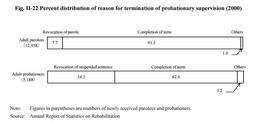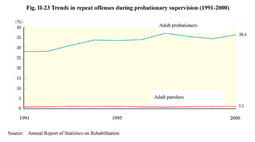| Previous Next Index Image Index Year Selection | |
|
|
4. Results of implementation of probationary supervision (1)State upon termination of probationary supervision
Fig. II-22 shows the percent distribution of parolees and probationers whose probationary supervision terminated in 2000, by reason for termination. The most common reason for termination of probationary supervision was the expiration of the period of probationary supervision, for 11,828 parolees and 3,246 probationers (including 488 who were granted provisional discharge of probationary supervision). As for the percentages of such parolees and probationers whose probationary supervision terminated due to revocation of parole and revocation of suspended sentence, viewed by type of offense at the time when the parolee or probationer was newly received by probation offices (excluding offenses for which the number of parolees and probationers whose probationary supervision terminated was less than 100), the percentage of termination due to the former reason was highest for larceny (12.4%), followed by Poisonous and Deleterious Substances Control Law violation (10.3%) and breaking & entering (9.1%) while the percentage of termination due to the latter reason was highest for larceny (42.6%), followed by fraud (37.1%) and Stimulant Drug Control Law violation (35.7%), in that order in both cases (Source:Annual Report of Statistics on Rehabilitation). Fig. II-22 Percent distribution of reason for termination of probationary supervision (2000) (2)Repeat offenses and reimprisonment Fig. II-23 shows the percentage of adult parolees and adult probationers whose probationary supervision terminated in 1991 and after, and those who were newly sentenced to a repeat offense that they committed during the period of probationary supervision (hereinafter called"repeat offense rate"). Fig. II-23 Trends in repeat offenses during probationary supervision (1991-2000) In 2000, the percentage of repeat offense was 1.1% (146 offenders)for adult parolees and 36.4% (1,889 offenders)for adult probationers. By type of offense at the time when the parolee or probationer was newly received by probation offices (excluding offenses for which the number of parolees and probationers whose probationary supervision terminated was less than 100), the percentage was highest for robbery (3.8%) in the case of adult parolees, followed by homicide (2.2%), breaking&entering (1.7%), and arson (1.6%) in that order, while it was highest for larceny (43.9%) in the case of adult probationers, followed by fraud (39.2%), Stimulant Drug Control Law violation (38.2%), and extortion (38.1%) in that order (Source:Annual Report of Statistics on Rehabilitation).As for the percentages of inmate released on parole and inmates released on completion of their sentence who were reimprisoned to penal institutions within 3 years of their release (recidivist reimprisonment rate), the rate has been consistently lower for parolees than for inmates released on completion of their sentence. Of those released in 1998, parolees accounted for 26.0% and inmates released on completion of their sentence (excluding those released from penal detention houses)for 44.8% (Source:Annual Report of Statistics on Correction). |

